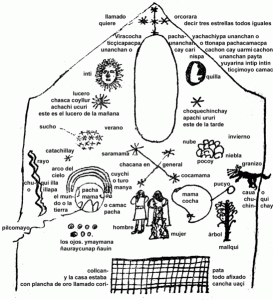Holy Week Sweets Have Sacred Meaning

Cuzco returns to normal today, after a week of celebration. The morning begins with celebratory mass, for those who wish to attend, in honor of Christ’s resurrection, while in the Plaza de Armas, at the edge of the Cathedral the regular Sunday parade is schedule to take place.
In this way, mass in the Cathedral and civic parade on its edge, the twin poles of a Spanish society are re-established after a week in which the society and religion seem the same. Durkheim’s sacred and profane are distinguished again, even if in a seeming bout of Inca revenge both have their own sacred and secular halves within them.
In the Church it is the diocesan order as opposed to the power and majesty of the mass, while in the state it is normal social life versus the symbols of the country, but I digress.
Instead of developing that point, let us look at something typical of Cuzco’s holy week, the empanada de semana santa.
Though called an empanada, which suggests a dough (fried or baked) containing a filling which you find when you bite into it, this is not your normal Hispanic empanada. It is flat with levels, rather than being a closed pocket with a hidden treat. That role is played in Cuzco by other foods, such as the tamale and the stuffed rocoto. And, it is also filled by more ordinary empanadas whose dough is a puff pastry.

This empanada is more like Cuzco’s classic pastel de fideo, fettuccine pie. It is laid flat. For the pastel it is in a pan, while the empanada appears on a sheet of paper. In both cases, they are composed is ingredients that stay distinct. The pastel has its noodles (fettuccine), olives, cheese, and beaten egg as a binder. In contrast, the pastel has the paper, a cake and what in Spanish are called grágeas.
Grágeas are a sprinkle of colored candy decorations across the surface of the cake. They can be nonpareils or candy sequins.They are always colored, like a rainbow.

The empanada comes in three layers, a base, a cake with a variegated surface, and the sprinkles. This reminds me of the classic idea of an Andean hierarchy, the world below, this world, and the world above, with the focus on the relationship between this world and the world above, the rainbow like candy treats.
The colors suggest a rainbow, but this sheet also is roughly reminiscent of something in the important drawing by Juan de Santa Cruz Pacachuti Yamqui Salcamaygua. His drawing places a large oval in the top center, with a cross of stars above it, and the sun and moon to either side.
Though not an oval, this empanada reminds me of that image, particularly with the stars above it. The movement of stars from one season to another takes this flat image and gives it motion.
Of course, there is another part of the image that we could also suggest as a background for understanding this food. That is the image of the earth, on the bottom left side, with a rainbow arching above it. Though the colors of the grágeas remind me of a rainbow, that celestial form is usually symbolized by an arch, sometimes with heads on either side.
The grágeas of the empanada are definitely a sprinkle, like stars scattered across the sky, and not and arch. The stars have color and in Spanish they say they centellear, that is they sparkle.
Part of why I suggest the empanada is reminiscent of the oval in Pachacuti Yamqui’s drawing is that the oval shines, it has a gleam. That gleam is like the reflection of sunlight on water, causing it to shine. As a result, it is a characteristic of the great, pre-Hispanic God Viracocha, the creator.
This theme of Viracocha continues in another Holy Week sweet in Cuzco, the suspiro or sigh. It is a meringue made like a dried, sweet foam. The word Vira (the first part of the god’s name that refers to glow, literally means fat and many people argue that it therefore is foam).
This two part set of Holy Week sweets is joined by a rosca and maicillos, making another four part set. But we will save these for a later note. For now, it is enough to recognize that the maicillos are made from cornmeal. If you look beneath the oval in Pachacuti Yamqu’s drawing, you will see another cross with stars. The upper left star is called saramama, which means the Lady of Corn.
It is far to easy to over interpret something like the empanada, but this correspondence with a classic drawing of Inca cosmology suggests that maybe, even if unspoken, the sweets of Holy Week are holy for more reasons than simply being served on this significant Christian occasion.
They may enclose holiness in themselves through the ways they index the structure of the world, deity, and people’s place in the cosmos.




